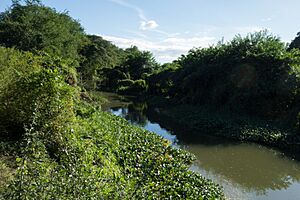Jaibo River facts for kids
The Jaibo River is a natural waterway located in southern Cuba. Rivers like the Jaibo are important parts of the landscape. They provide fresh water and support many different kinds of plants and animals. The Jaibo River flows through its region, shaping the land and connecting different areas.
Contents
What is a River?
A river is a natural stream of fresh water. It flows across the land, usually towards an ocean, a sea, a lake, or another river. Rivers begin at a source, which might be a spring, a melting glacier, or even a lake. As they travel, they collect water from smaller streams called tributaries.
The Journey of a River
The journey of a river can be long and winding. It often starts in high areas, like mountains or hills. Here, the water flows quickly, carving out valleys and canyons. As the river moves to lower, flatter land, its flow slows down. It might create wide bends called meanders. Finally, the river reaches its mouth, where it empties into a larger body of water.
Location and Path of the Jaibo River
The Jaibo River is found in the southern part of Cuba. Cuba is a large island nation in the Caribbean Sea. The river flows through the Guantánamo Province, which is in the eastern part of Cuba. It makes its way through the landscape, carrying water and nutrients.
How Rivers Shape the Land
Over many years, rivers like the Jaibo help to shape the land. Their flowing water can erode, or wear away, rocks and soil. This process creates valleys and channels. Rivers also carry sediment, like sand and mud. They deposit this sediment in other places, building up fertile plains and deltas. This constant movement changes the landscape over time.
Importance of the Jaibo River
Rivers are vital for many reasons. The Jaibo River, like other rivers, plays a key role in its local environment. It provides essential resources for both nature and people.
Water for Life
The most important role of a river is providing fresh water. People living near the Jaibo River might use its water for drinking, farming, and other daily needs. Animals also rely on the river for hydration. Many plants need the river's water to grow and thrive in the surrounding areas.
Home for Wildlife
Rivers are rich habitats for many different species. The Jaibo River supports a variety of plants and animals. Fish, insects, and amphibians often live in the river itself. Birds and mammals visit the riverbanks to drink and find food. The river's ecosystem is a delicate balance of living things.
Aquatic Life
In the waters of the Jaibo River, you might find various types of fish. These fish depend on the river's flow and water quality. Small invertebrates, like insects and crustaceans, also live in the river. They form an important part of the food chain for larger animals.
Plants Along the Banks
The areas along the Jaibo River's banks are often lush with vegetation. Trees, shrubs, and grasses grow well here because of the constant water supply. These plants help to stabilize the soil and prevent erosion. They also provide shelter and food for many land animals.
Protecting Rivers
Rivers like the Jaibo are precious natural resources. It is important to protect them from pollution and overuse. Keeping rivers clean helps to ensure that they can continue to provide water and support wildlife for future generations.
Conservation Efforts
Conservation means protecting natural environments. Efforts to conserve rivers often include reducing pollution from homes and farms. It also means managing how much water is taken from the river. Protecting the areas around the river, called riparian zones, is also important. These efforts help keep the river healthy.
See also
- List of rivers of Cuba
- In Spanish: Río Jaibo para niños


